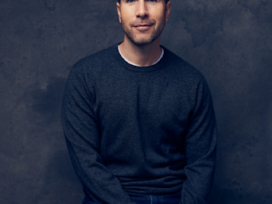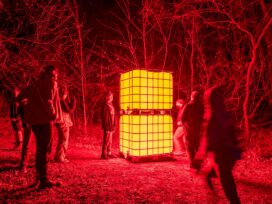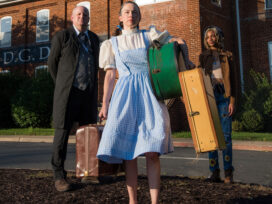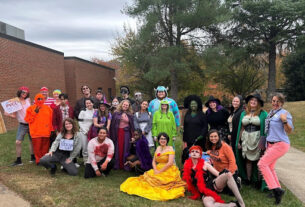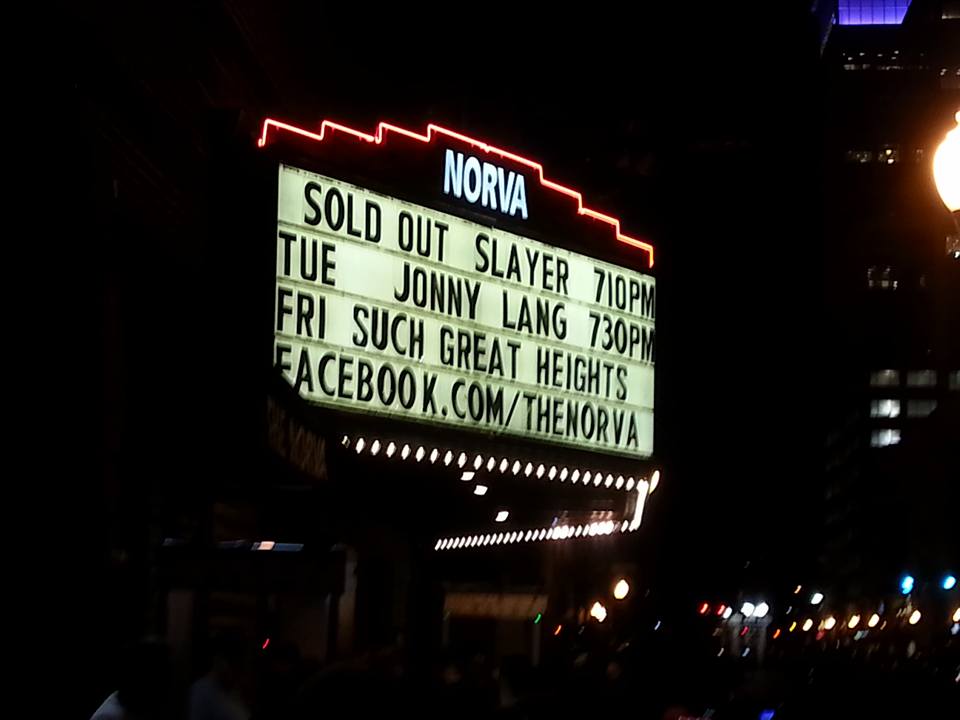
Thrash Metal Mauls 2016
Joe Fowler, staff writer
“How would you feel about seeing Slayer, Anthrax and Death Angel?” Steve’s message repeated in my mind as I pulled in to the Millie Joe’s parking lot. It was worth staying up all night and walking around PVCC in a sleep-deprived delirium, spouting off conspiracy theories the next day, I thought. As David said later, “You succumbed to the Stockholm Syndrome, got some metal religion in your soul, and ended up bleating ‘Hail Slayer’ with the rest of us droids.”
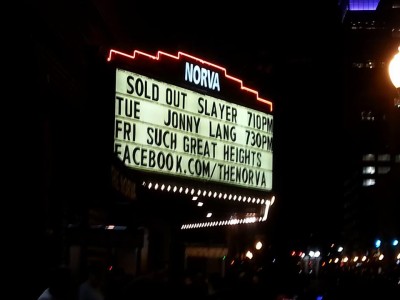
So to Norfolk we traveled. Steve drove; the previously nameless Max rode shotgun. David and I sat in the backseat. Jumping out of the car to freedom was not an option on the interstate. I decided to join in the banter instead since I had essentially allowed these people to abduct me.
We all began talking about the usual topics – the history of heavy metal; how it has grown into a way of life for many over the last four decades; and personal stories of the life. David told of his initial exposure to shock rocker Alice Cooper at the base record store in Nam, admitting that a Black Sabbath album was also available, but that he was not quite ready for Ozzy and company at the time. Those were the days of yore, of course, and David later came to see reason.
Steve discussed his early ventures into the heavy metal culture dating back to the mid- 1980s. “When I heard Master of Puppets … everything changed,” he said in reference to Metallica’s 1986 classic, which appears frequently on top 10 lists for the greatest metal albums of all time.
Max, though versed in the ways of metal, confided that the show in Norfolk would be the first strictly heavy metal concert he had attended. I admired him for choosing Slayer as his first. The band has terrified record labels, parents and the legislative branch for 35 years.
Live Thrash: The Eternal Reign
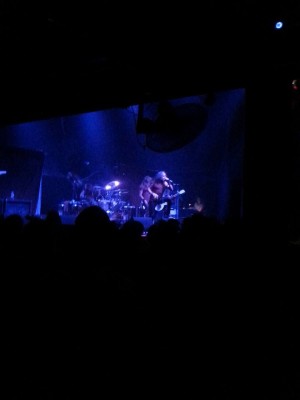
Death Angel took stage first at The NorVa. While many opening acts receive a fantastic crowd reaction, it often seems as though fewer concert goers give them the same priority treatment as the later acts. Such was not the case with Death Angel. Fans packed The NorVa prior to the set. Thrash metal sing-a-longs began early in the Death Angel performance. Lead singer Mark Osegueda called for horn hand gestures almost immediately upon taking stage. The movement in the pit began intensifying in under half an hour. Death Angel tore into their substantial catalog of music for 45 minutes. The vibe in the venue resembled the early stages of a strong acid trip. We all knew our time in reality was coming to a close. How far would this journey take us?
Perceptions of the world beyond The NorVa vanished as Anthrax took to the stage. When thrash metal pioneer, and last remaining founding member of the band, Scott Ian, walked on stage, the true power of the show, the entire movement, became apparent. Members of the audience speculated aloud about which songs the band would play that night. The opening riff of “Caught in a Mosh” sent the pit into a frenzy that spread out to the sides until the entire floor resembled a roaring ocean of humanity with only the solidarity of the moment to keep us all from drowning. We were the sea.
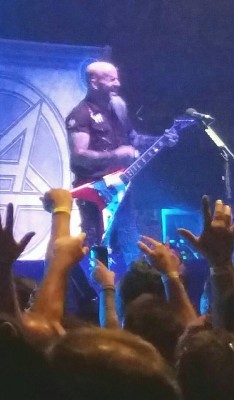
The intensity and fun continued as fans drifted in and out of the pit area. Lead singer, Joey Belladonna announced a special treat for the audience to close the set before the band launched into “Indians”, a Native-American protest song released on the 1987 album Among the Living before more politically correct terms became commonplace. Belladonna sung, “Forced out – brave and mighty; stolen land – they can’t fight it; hold on – to pride and tradition even though they know how much their lives are really missing. We’re dissin’ them – on reservations, a hopeless situation.” I watched in awe as devil horn hand gestures turned into fists of defiance, leading up to Belladonna’s cry of, “War dance!” when the audience burst with explosive force.
This was not simple entertainment, and the fans were not nihilistic children who cared about nothing. This was metal: the music, the meaning, the movement. Anthrax finished their set, leaving an exhausted audience to reach deep inside and pull on their reserves to cheer on the one force of nature willing to discuss the dark side of humanity without regard for criticism – Slayer.
A cloth screen obscured the stage area. Crucifixes rotated around in circles from upright to inverted and back again. Contemplation afterward led to the conclusion that the images represented complete disregard as opposed to anything sacrilegious. Whatever the symbolism, the chant of “Slayer” began when the images appeared.
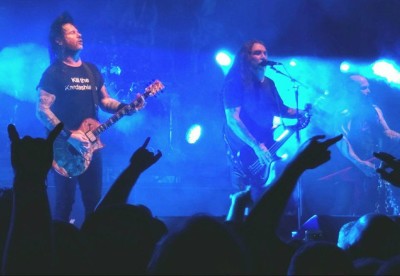
Slayer launched into their set with unmatched intensity, their instruments screaming, “Cry ‘Havoc,’” with enough ferocity that the betrayers of Caesar would have fallen on their swords in search of mercy. There was none to be found in The NorVa.
“This is getting crazy,” a fan said nearby, while Slayer played a slow ominous groove amidst the smoke and black and blue lights.
It was just beginning. Vocalist Tom Araya presented an indictment of the world through the lyrics of the songs. He sang of war crimes, PTSD, casualties of war, mass murder and serial killers, killing over beliefs and more before the entire audience screamed, “God hates us all!” during the song Disciple.
Though the lyrics are dark, Araya said, “I have a really strong belief system and these are just words and they’ll never interfere with what I believe and how I feel,” according to Jenny Feniak of the Edmonton Sun.
And true to that comment, Araya spoke to the audience of passion, of obsessive love and loving someone to death, the usual lead into “Dead Skin Mask”, a song about serial killer Ed Gein. The audience sang along to the eerie lyrics: “Dance with the dead in my dreams. Listen to their hallowed screams. The dead have taken my soul. Temptation’s lost all control.”
The set continued with Slayer rousing the crowd with classics like “War Ensemble” and “Seasons in the Abyss”. Then there was a pause in the music with the exception of drum beats every few seconds and random guitar feedback. Was the show over?
Not quite. The random noise was a traditional teaser of sorts for the one moment most fans look forward to leading up to a Slayer show, the second the opening riff of “Raining Blood” breaks the silence. “Raining Blood” is the one song guaranteed to transform thousands of people into a single unified mass. There are many signs that a person has truly lived. Being a part of such a moment in live music is one of them.
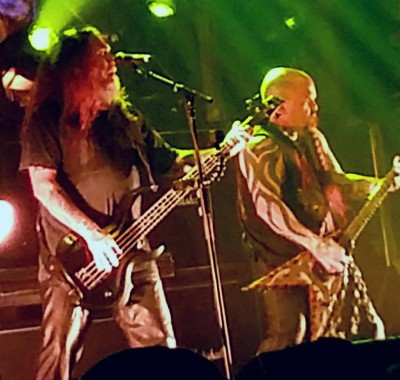
But the truly special aspect of the entire day was the amount of diversity and solidarity I had the honor of participating in. From the random invitation from acquaintances I rarely interact with on a regular basis, to the stories of Vietnam and other events of decades past and present, just the ride down was amazing.
In line, outside of the show, an African-American man showed off his black-on-black Anthrax hat, happy that he got one before they sold out. The amazing amount of energy and enthusiasm during Anthrax’s performance of Indians literally stood my hair on end considering the events in the North Dakota.
All of those things touched my heart in a special way, but none so much as the two women heading to the pit during the Slayer set, one of them just under five-feet-tall. That was one of the most amazing things I have ever seen simply because it really meant nothing to the people in attendance. She was just another Slayer fan heading to the pit. In a world where people can be attacked verbally, mentally or physically just because of appearance, beliefs and even their thoughts, there still exists bastions of true justice and equality.


